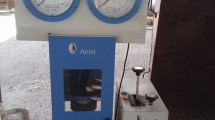Abstract
The effects of fly ash on the compressive strength, pore size distribution and chloride-ion penetration of recycled aggregate concrete were investigated. Two series of concrete mixtures were prepared. The concrete mixtures in series I had a water-to-binder ratio and a cement content of 0.55 and 410 kg/m3, respectively. The concrete mixtures in series II had a water-to-binder ratio and a cement content of 0.45 and 400 kg/m3 respectively. Recycled aggregate was used as 20%, 50%, and 100% replacements of natural coarse aggregate in the concrete mixtures in both series. In addition, fly ash was used as 0%, 25% and 35% by weight replacements of cement. The results show that the compressive strengths of the concrete decreased as the recycled aggregate and the fly ash contents increased. The total porosity and average porosity diameter of the concrete increased as the recycled aggregate content increased. Furthermore, an increase in the recycled aggregate content decreased the resistance to chloride ion penetration. Nevertheless, the replacement of cement by 25% fly ash improved the resistance to chloride ion penetration and pore diameters and reduced the total porosity of the recycled aggregate concrete.
Similar content being viewed by others
References
CS Poon and Salman Azhar. An Investigation on the Scope and AppliCations of Recycled Aggregates in the Hong Kong Construction Industry[J].One day Annual Seminar on Environmentally Friendly Structures, 2001 (5):45–54
Collins RJ. Recycled Aggregates-application and Control Issues [C].In:Proceeding of the International Conference on the Use of Recycled Concrete Aggregates. Edited by RK Dhir, NA Henderson and MC Limbachiya, Thomas Telford, UK, 1998:169–175
CS Poon, SC Kou and L Lam. Use of Recycled Aggregates in Moulded Concrete Bricks and Blocks[J].Construction and Building Materials, 2002, 16:281–289
PJ Wainweight, A Trevorrow, Y Yu Y Wang. Modifying the Performance of Concrete Made with Coarse and Fine Recycled Concrete Aggregates[M]. In: EK Lauritzen (Ed),Guidelines for Demolition and Reuse of Concrete and Masonry, E & FN SPON, Denmark, 1993:319–330
IB Topcu, S Sengel. Properties of Concretes Produced with Waste Concrete Aggregate[J].Cement and Concrete Research, 2004,34:1307–1312
JZ Xiao, JB Li, Ch Zhang. Mechanical Properties of Recycled Aggregate Concrete under Uniaxial Loading[J].Cement and Concrete Research, 2005,35:1187–1194
RK Dhir, MC Limbachiya, T Leelawat. Suitability of Recycled Concrete Aggregate for Use BS 5328 Designated Mixes [J].Proc. Instn Civ. Engrs & Bldgs, 1999,134(8): 257–274
H Uchikawa, S Hanehara.Recycling of Concrete Waste[M]. In: RK Dhr, TD Dyer (Eds), Concrete for Environment Enhancement and Protection, E&FN SPON, London, 1996: 163–172
JM V Gomez-Soberon. Porosity of Recycled Concrete with Substitution of Recycled Concrete Aggregates an Experimental Study[J].Cement and Concrete Research, 2002,32:1301–1311
A Mueller, A Winkler.Characteristics of Processed Concrete Rubble[M]. In: KR Dhir, NA Henderson, MC Limbachiya (Eds), Uses of Recycled Concrete Aggregate. Sustainable Construction, Tomas Telford, London, 1998:1109–1119
PJ Wainwright, JG Cabrera.Use of Demolition Concrete to Produce Durable Structural Concrete[M]. In: J J K M Goumans, H A Van Der Sloot, T G Aalbers (Eds) Environmental Aspects of Construction with Waste Materials, Elsevier, The Netherlands, 1994:553–562
B Zhang. Relationship between Pore Structure and Mechanical Properties of Ordinary Concrete Under Bending Fatigue[J].Cement and Concrete Research, 1998,28(5):699–711
British Standard Institute, BS 812: Part 103. 1.Methods for Determination of Particle Size Distribution[S], 1985
BS 1881 Part 116.Testing Concrete Part 116: Method for Determination of Compressive Strength of Concrete Cubes[S]. British Standards Institution, 1983
BS 7591 Part 1.Method of Evaluation by Mercury Porosimetry [S]. British Standards Institution, 1992
Leng F, Feng N and Lu X. An Experimental Study on the Properties of Resistance to Diffusion of Chloride Ions of Fly Ash and Blast Furnace Slag Concrete[J].Cement and Concrete Research, 2000,30(6):989–992
Mindess S, Young JF and Darwin D.Concrete[M]. 2nd edition, Prentice Hall, 2003
Author information
Authors and Affiliations
Corresponding author
Additional information
Funded by the Environment and Conservation Fund, the Woo Wheelock Green Fund and the Hong Kong Polytechnic University
Rights and permissions
About this article
Cite this article
Shicong, K., Poon, C.S. Compressive strength, pore size distribution and chloride-ion penetration of recycled aggregate concrete incorporating class-F fly ash. J. Wuhan Univ. Technol.-Mat. Sci. Edit. 21, 130–136 (2006). https://doi.org/10.1007/BF02841223
Received:
Accepted:
Issue Date:
DOI: https://doi.org/10.1007/BF02841223




